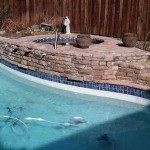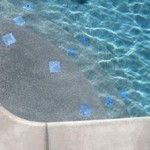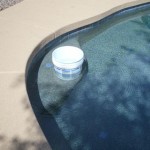During a home inspection this week a customer ask if they should re-surface the plaster pool or update to an Aggregate surface. They also wanted to know the advantages and disadvantages of both. I sent them this article I did last summer and decided to re-run it on my blog.
The three main in ground pool surfaces are plaster, aggregates (commonly known as “Pebble Tec”) and tile.
Plaster is the most affordable pool finish product on the market. Plaster has a life expectancy of 6-8 years. Constant interaction with water, its chemicals and other factors, may cause discoloration over time. Acid washing the pool is typically required every couple years to maintain the bright white look. Painting the pool surface is an inexpensive way of covering over a heavily stained plaster pools. During home inspections I am finding small hairline cracks in more of the plaster pool surfaces due to water levels not being maintained on the vacant homes. Plaster that is exposed to the summer sun can deteriorate within a couple days and may need re-plastering.
Aggregate pool surfaces are more expensive but have a longer life expectancy and warranty compared to traditional plaster pools. The stone material is less impervious to attack or alterations in appearance due to lack of proper pool maintenance. The aggregate can be exposed to the sun without damage to the surface in most cases. The exposed aggregate can be rough on some people’s skin making it less appealing than the smoother plaster finish. Also algae on the surface can be harder to detect due to the textured surface. Newer aggregate pools tend to have smaller polished stones that are less abrasive to the skin.
Tile has the longest life span compared to other materials. It is also the most expensive due to the material and the time it takes to install. Although the tile last a long time the grout between the tiles erode away over time due to pool chemicals and needs to be replaced. This is also true of the tiles around the top edge of most other pools.
Leaks in any type of pool are not always detectible during a home inspection. Cracks may not be visible due to debris in pool or reflections from the water. Cracks or gaps can also be at one of the supply or return line penetrations through the surface, or in the underground line itself. To check for a leak at a crack you can place food coloring in the water next to the crack and see if it is drawn into the crack. The best way I know of checking yourself for leaks is to place a bucket of water on the pool step and fill it with pool water to the same level as the pool. Turn off all pumps and auto-fill valves for a couple days. If the water level in the pool is lower than the bucket than there is a good chance you have a leak. All cracks or suspected leaks should be reviewed by a qualified pool company for repair.






Sorry, comments are closed for this post.